| [From the Office of International Affairs] |
|
|
| [From the Office of International Affairs] |
|
|
|
In 2005, the Financial Services Agency (FSA) conducted a fact-finding survey on hedge funds in Japan and published the findings in a report titled ''Summary of Hedge Fund Survey Results and the Discussion Points'' on December 13, 2005 (the English version was released on December 22, 2005) 1. The Survey was the first fact-finding survey ever conducted on Japan's hedge fund market, and many responses were received both at home and abroad. The following is an overview of the Survey results. Please note that all opinions stated hereunder are the writer's personal opinions. |
||||||||||||
Global Market Size for Hedge Funds exceeds $1 Trillion The hedge fund market has been growing dramatically in recent years. According to the survey conducted by an American hedge fund research company, the size of hedge fund market--which was worth US$324 billion in early 2000--exceeded US$1 trillion for the first time by early January 2005, and is still growing (refer to Figure 1). |
||||||||||||
Figure 1: Number and Asset Size of Hedge Funds |
||||||||||||
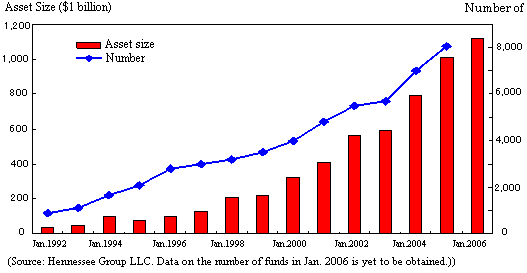 |
||||||||||||
Under these circumstances, regulatory authorities are paying more attention to hedge funds. In particular, as it is said that cross-border activities of hedge funds have become more vigorous, there is growing recognition that further cooperation among regulatory authorities is needed to monitor and regulate their activities. Accordingly, many regulatory authorities are making proposals and taking measures with respect to hedge funds, including the International Organization of Securities Commissions (IOSCO), which consists of securities regulators of the world. In Japan, the study of issues of hedge funds is declared as one of the concrete efforts to be made under the Program for Further Financial Reform - Japan's Challenge: Moving toward a Financial Services Nation formulated and announced in December 2004. We have also participated actively in discussions at international conferences, including those of IOSCO. |
||||||||||||
What are Hedge Funds? |
||||||||||||
| It is extremely difficult to define hedge funds. There is no clear
definition, not only in Japan but also in any other countries and international
organizations. For example, according to the IOSCO report2
published in February 2003, hedge funds have ''at least some of the following
characteristics: (1) borrowing and leverage restrictions, which are typically
included in collective investment scheme (CIS) regulations, are not applied, and
many (but not all) hedge funds use high levels of leverage; (2) significant
performance fees (often in the form of a percentage of profits) are paid to the
manager in addition to an annual management fee; (3) often significant 'own'
funds are invested by manager; (4) derivatives are used, often for speculative
purposes, and there is an ability to short sell securities; and (5) more diverse
risks or complex underlying products are involved.'' However, it also states
that it is ''extremely difficult to arrive at a legally sound description for
the purposes of laws and statutes.'' Nevertheless, in some IOSCO member countries, funds that have some of the following characteristics are considered as hedge funds: (1) use of short-selling and leverage; (2) subscription through private placement; (3) investment in various types of assets; and (4) diverse investment strategies. In addition, charge of performance fees is also considered one of characteristics unique to hedge funds. In consideration of the above, we defined hedge funds as the funds (including funds of hedge funds (FOF)) with the following three components in this Survey for the purpose of identifying the actual state of hedge funds in Japan as broadly as possible: (1) use of leverage; (2) charge of performance fee; and (3) use of hedge fund investment strategies. Considering that the number of publicly offered investment trusts with hedge fund strategies aimed at general (individual) investors established and sold has been increasing recently, we decided to cover both publicly offered funds and privately placed funds in this survey. (In this Survey, the interpretation of the definition of hedge funds was left to the respondents (financial institutions). As the interpretation might vary between the respondents, it should be noted that such variation might have affected the Survey results.) |
||||||||||||
Overview of Survey |
||||||||||||
| In this Survey, the FSA sent a questionnaire to 1,251 financial institutions (''surveyed companies'') under its jurisdiction (deposit-taking financial institutions, insurance companies, securities companies, investment trust management companies, investment advisors, etc.) and requested them to respond on a voluntary basis. Specifically, three types of questionnaires to identify the actual state of hedge funds from three angles, namely, from the respective viewpoints of arrangement/management of hedge funds, distribution of hedge funds and investment in hedge funds (refer to Table 1). We also interviewed more than ten companies that were relatively large as hedge fund arranger/distributor/investor. | ||||||||||||
Table 1: Survey Items, etc. |
||||||||||||
|
||||||||||||
Characteristics of Hedge Fund Market in Japan |
||||||||||||
| In the Survey, questionnaires were sent to 1,251 financial institutions, of which 1,171 responded, as summarized in Table 2. | ||||||||||||
Table 2: Summary of Survey Results |
||||||||||||
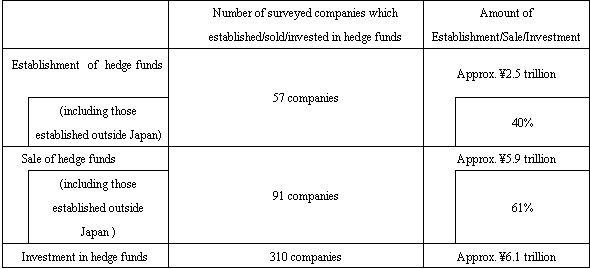 |
||||||||||||
|
The survey results show that about 60% of approx. ¥5.9 trillion worth of hedge funds sold by financial institutions in Japan was established outside Japan. As hedge funds sold to financial institutions accounted for about 50% of approx. ¥5.9 trillion worth of hedge funds (refer to Table 2), a considerable portion of approx. 6.1 trillion worth of hedge funds held by financial institutions may be deemed to have been established outside Japan. The increase in the amount of hedge funds sold to individual investors is also outstanding. Accordingly, it is fair to say that the hedge fund market in Japan is largely characterized by funds established overseas that are imported into Japan, and the increasing acceptance of hedge funds among individual investors. While the amount of hedge funds held by financial institutions amounted to approx. ¥6.1 trillion, about 50% of the cumulative total amount of hedge funds sold over the past five years (¥5.9 trillion) was sold to non-financial institutions. Accordingly, the hedge fund market in Japan is estimated to be worth almost ¥10 trillion. |
Amount of established hedge funds approach ¥1 trillion: Those established outside Japan account for approx. 40% Hedge funds established substantially increased both in number and in amount in fiscal 2003, approaching ¥1 trillion in amount (refer to Figure 2). By country of establishment, hedge funds established in Japan accounted for 60% in amount, while those established in foreign countries such as the Cayman Islands and Ireland accounted for the remaining 40%. These countries were chosen because of lower establishment costs, etc. compared to Japan. Hedge funds offered through private placement accounted for more than 80% of all hedge funds in amount. |
Figure 2: Number and Amount of Hedge Funds Established |
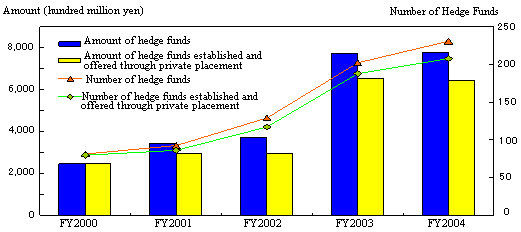 |
Acceptance of Hedge Funds by Individual Investors The amount of hedge funds sold has been dramatically increasing since 2003, as in the case of the amount of hedge funds established (refer to Figure 3). |
Figure 3: Amount of Hedge Funds Sold |
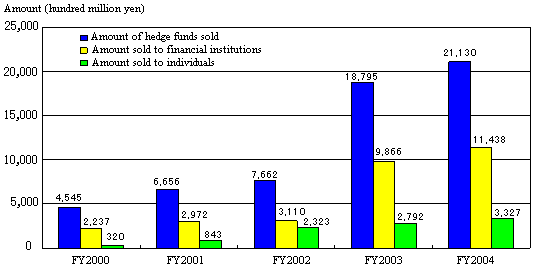 |
| By buyer, financial institutions have accounted for about 50% of all buyers on average over the past five years. What is noteworthy here is that the amount of hedge funds sold to individual investors has increased dramatically: more than tenfold over the past five years (refer to Figure 4). This characteristic is extremely interesting for those engage in discussions on how to deal with hedge funds in light of investor protection. |
Figure 4: Growth in Amount of Hedge Funds Sold |
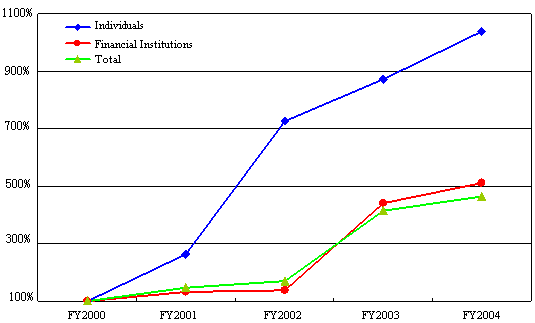 |
| As for the breakdown of sales of hedge funds by country of establishment, approx. 40% of all hedge funds sold in Japan during the survey period were established in Japan, while the remaining 60% were established in foreign countries (refer to Figure 5). Furthermore, 56% of hedge funds sold by domestic securities companies and 84% of hedge funds sold by foreign securities companies were established outside Japan. Accordingly, it is fair to say that funds established outside Japan are being imported and sold in Japan. |
Figure 5: Sales of Hedge Funds by Country of Establishment |
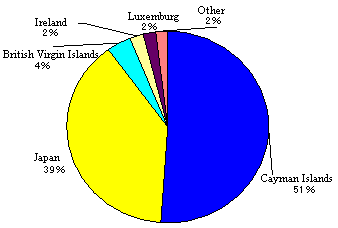 |
| This provides a significant hint on how the FSA should deal with hedge funds. In other words, there will be difficulties involved in directly overseeing the hedge funds or hedge fund arrangers/managers themselves. Also, it will be indispensable to work with foreign authorities to accurately identify their activities to the extent needed. On the other hand, it will be necessary to oversee how risks are managed by financial institutions. |
Diversification of Hedge Funds |
| As of March 31, 2005, a quarter of all surveyed companies (310 companies) held hedge funds worth about ¥6.1 trillion. Their holdings substantially increased especially in fiscal 2003 (refer to Figure 6). This substantial increase in the amount of hedge funds established is considered to be attributable to financial institution's growing needs to invest in hedge funds. |
Figure 6: (Reference) Annual Trends in Amount Invested in Hedge Funds |
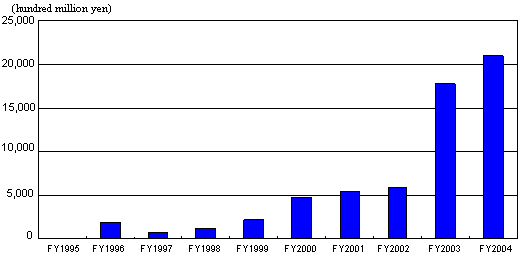 |
| (Note) Past investments which have already been redeemed, withdrawn, etc. are not included in this Figure. |
The increase in investment in hedge funds is considered to be attributable to the drive to seek absolute returns by building a portfolio resistant to the impact to market fluctuations that has limited correlation with conventional investment products such as stocks and bonds, in response to persistently low interest rates and the sagging stock market. Hedge funds have generally been regarded as high-risk, high-return investment products in the past. However, FSA's survey has revealed that many surveyed companies actually recognized them as middle-risk (middle-return) investment products due to the single-digit risk profile (standard deviation) of hedge funds compared to, for example, the +10% risk profile of TOPIX. This is an interesting aspect. Put differently, it may be fair to say that hedge funds--which used to offer products with high returns (i.e., high risks) by utilizing excessive leverage back in the day as did the Long Term Capital Management (LTCM)--gradually started providing products aimed at generating stable returns in addition to them. Some analyses point out that such trends are due to hedge funds investors shifting from wealthy individuals to institutional investors seeking stable returns. Nonetheless, the actual status of risks of hedge funds needs to be identified in greater detail, and it is premature to conclude that ''hedge funds = middle risks'' at this point. |
Risks of Investing in Hedge Funds Figure 7 shows the investment balance by hedge fund investment strategy (refer to Table 3). While Funds of Hedge Funds (FOHF) account for 67% of the total, the percentage of FOHF with respect to investment balance is positively correlated with the amount of investment. While further fact-finding is required to analyze the factors behind this, the findings of this Survey suggest that there is a possibility that investors who invest smaller amounts in hedge funds are investing in funds with higher risks, considering that FOHF is generally aimed at diversifying risks compared to single funds. |
Figure 7: Amount of Investment by Hedge Fund Strategy |
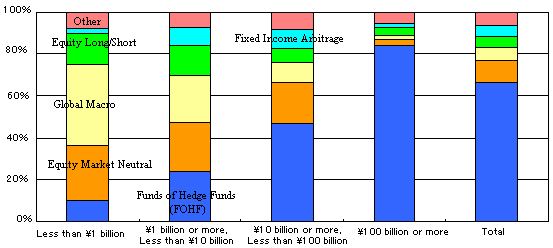 |
Table 3: List of Hedge Fund Strategies |
|||||||||||||||
|
|||||||||||||||
|
|||||||||||||||
As for the breakdown of hedge funds held by each type of business, regional banks and cooperative financial institutions accounted for approximately 20% of the total in terms of balance (refer to Figure 8). Although it is not necessary clear from the Survey findings, hedge funds may have been one of the preferred investment vehicles for surplus funds in which high returns appear to be promising, amid the continual fall in the deposit-loan ratio. |
|||||||||||||||
Figure 8: Hedge Funds held by Type of Business |
|||||||||||||||
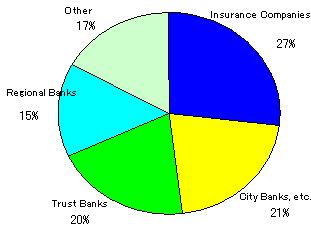 |
|||||||||||||||
| Hedge fund investors need to understand the risks unique to hedge funds. Firstly, it is generally difficult for investors to grasp the portfolio of hedge funds in detail. This is because the detailed disclosure of investment strategies, subjects of investment, etc. might lead to a loss of profit-making opportunities for the fund manager. The same applies to the valuation of net asset value; there might be risks not found in conventional investment products, such as those relating to the appropriateness of the valuation method, and objective verification of the valuation. It is also necessary to note that hedge funds are extremely illiquid. In general, it is deemed to be extremely difficult to sell hedge funds to a third party, and many of them set a lock-up period during which withdrawals will incur penalties. It is also said that in many cases, it takes a relatively long period of time to get the investments actually converted into cash after giving a notice of withdrawal. Financial institutions must improve their respective risk management systems by giving due consideration to the following. Specifically, it is vital that financial institutions establish investment policies and investment rules that can deal with investments in hedge funds as well. As a matter of course, it is also necessary for financial institutions to have sufficient understanding of the nature of the investment products to the greatest extent possible. Moreover, if a financial institution measures the risks of hedge funds based on an internal model (Value-at-Risk (VAR), etc.), it is necessary to take the aforementioned risk factors into account when building a model. It is particularly important to carry out sufficient stress testing. In addition, if a financial institution extends loans to hedge funds, counterparty risks exist. When executing a loan for them, financial institutions need to fully identify the actual status of the counterparty. |
|||||||||||||||
Treatment under Basel II The following is a review of the situation in Japan regarding Basel II, the new capital adequacy framework. In the draft released for public comment by the FSA on December 28, 2005, as a general rule, a financial institution taking a standard approach is required to calculate risk assets of a hedge fund by firstly identifying the portfolio of the fund's assets and then calculating the total amount of credit-risk assets in the portfolio. On the other hand, a financial institution that takes an Internal Rating-Based Approach (IBA) may assume that the amount of credit-risk assets is equal to: |
|||||||||||||||
|
|||||||||||||||
| As shown above, hedge fund holdings are treated in a more risk-sensitive manner under Basel II. Therefore, due consideration must be given to these aspects when investing in hedge funds. | |||||||||||||||
Future Approach Hedge fund regulations in different countries can broadly be divided into two types: (1) regulations which require the person who deals in hedge funds to be registered with the authorities; and (2) regulations that require the hedge funds themselves to be registered with the authorities if they are sold to general investors. Examples of the former regulations are found in the U.S.A., U.K., Hong Kong and Japan, while the latter is found in Germany. As explained above, difficulties will be involved in directly regulating and overseeing the funds themselves. Therefore, the most rational thing to do under the current circumstances is: to monitor what kind of hedge funds financial institutions are investing in and how they are managing the risks, and if they are extending loans to hedge funds, etc., how they are managing those risks; and to enable the sharing of necessary information on hedge funds involved in cross-border activities with precision, by further enhancing cooperation with foreign authorities. In conjunction with this, we will conduct studies as necessary to look into how investors should be protected in consideration of the extent to which hedge funds are accepted by individual investors, while keeping a close eye on international discussions. |
| 1 | For more information, please refer to FSA's website. [return] | |
| 2 | Regulatory and Investor Protection Issues Arising from the Participation by Retail Investors in (Funds-of) Hedge Funds [return] | |
|
|
| [Next Page] |